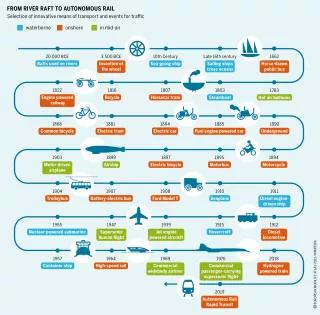
It took until the late 1980s to make transport part of EU policy. Since then, steps have been taken towards a more ambitious transport policy. Reluctance in EU Member States to enforce the rules keeps being the biggest obstacle.

In 1983, the European Parliament (EP) introduced a complaint against the then Council of the European Communities (now Council of the EU) because of its inactivity in Transport and Mobility Policy. The European Court of Justice consequently urged the Council to start developing a common transport policy. At its Milan summit in June 1985, the EU heads of state confirmed that European Transport and Mobility Policy should become an official part of EU competence. Over the following years, EU policy was focused on borderless liberalisation and growth of the European internal transport market.
With the 1993 White Paper on Growth, Competitiveness and Employment, the European Commission (EC) tried to boost cross-border transport infrastructure. But it was not until ten years later that a stronger legal base was set up for EU co-financing of the Trans-European Transport Networks (TEN-T) through the Connecting Europe Facility (CEF).
Harmonisation of rules in favour of transport safety, with a focus on roads, has been partly but still insufficiently realised. As an example, in January 1987, the EC published a communication on speed limits on EU roads. Mainly the United Kingdom and Germany blocked any European initiative on speed limits, although transport safety is partially a field of EU competence.
Over the last decade, under pressure from the EP, the EU intensified its actions and decisions towards a more ambitious transport and mobility policy. This includes the fields of road charging for trucks, standards of weights and dimensions of trucks and better passenger rights. On top of that came a more sustainable infrastructure legislation through the CEF, stronger cross-border integration of the different transport modes based on interoperability, intermodality and interconnectivity as a new set of policies. With its 2011 White Paper: Roadmap to a Single European Transport Area Towards a competitive and resource efficient transport system, the EC aimed high. By 2050 it wants no more conventionally-fuelled cars in cities; 40 percent use of sustainable low-carbon fuels in aviation; at least 40 percent cut in shipping emissions and a 50 percent shift of medium distance intercity passenger and freight journeys from road to rail and waterborne transport. All of which will contribute to a 60 percent cut in transport emissions by the middle of the century.
But the largest problem remains unsolved: the lack of enforcement by the Member States and the limited activity by the Commission in overseeing the application of EU legislation and decisions.
Another historical challenge stems from transnational coordination and shared responsibilities. Switzerland and Austria, for instance, have invested hugely in a better infrastructure with the construction of the cross-border base tunnels of Brenner, Gotthard and, most recently, Ceneri. The hinterland connection in other Member States, specifically Germany, is still lacking far behind, due to the country's transport policy focus on roads.
Getting the prices right and applying the polluter-pays principle by internalising external costs was already proposed by the Greens in the EP during the 1990s and is now a recognised principle in the Eurovignette directive for trucks.
As far back as in 1991, the EU intended to open rail markets and to separate operational matters from the infrastructure network. Over the following decades, four railway packages fixed rules for the European Union Agency for Railways (ERA), further opening the rail market, improving the interoperability and safety of national networks and developing a European rail transport infrastructure. The Europeanisation of railways remains the most crucial aspect, as considerable investments are still missing. The introduction of a Europe-wide digital railway controlling system (ERTMS) and the retrofitting of rail freight wagons for noise reduction are promising initiatives, but insufficiently enforced by the Member States.
There is a never-ending conflict between sustainable transport and mobility policies on the one hand and the EC's prioritisation of a competitive internal market on the other. Despite all efforts, there is still a long way to go to complete a comprehensive EU transport policy concept on avoidance and reduction of transport volumes.
Sources for data and graphics: Matthias Finger et al: EU Transport Policy, https://bit.ly/35CwZlG; Ethem Pekin, EU Transport Timeline, https://bit.ly/3e4L5jR; Timeline of transportation technology, Wikipedia, https://bit.ly/31P4jEX

